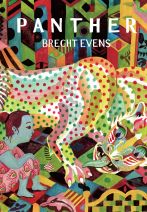Panther, by cartoonist Brecht Evens, is a colourful and sombre psychological thriller about the troubling relationship between a small girl and a fantastical creature.
The young Belgian artist (born in 1986) is well known in the world of alternative comics. From a country celebrated for its rich comics tradition, Evens studied illustration in Ghent and is part of a scene that includes the iconoclast Brecht Vandenbroucke (also published by Drawn & Quarterly) and the innovative Olivier Schrauwen (who is with Fantagraphics). He received the prestigious Angoulême prize in 2011 and has also been nominated for an Eisner (arguably the highest honour for a comic book artist) for Best Painter/Multimedia artist. Evens has shown in his previous books, The Wrong Place and The Making Of (both D&Q) that he is a virtuoso with an exuberant style, unique in the graphic novel world.

Panther
Brecht Evens
Drawn & Quarterly
$32.95
cloth
120pp
9781770462267
The graphic novel tells the story of Christine, a naive and fragile young girl who is bereaved by the death of her cat. When the charming and enormous Panther, self-proclaimed prince of Pantherland, arises from her bedroom dresser at night to enchant and comfort her, Christine accepts the feline’s friendship without hesitation. But it is clear from the beginning that Panther is up to no good. The shape-shifting trickster can fool the girl but the reader sees through him – and fears for her. The predictability of her victimization by her abuser and her lack of agency somehow do not undermine the narrative tension, which is kept tight by the author’s ability to blend text and images so smoothly that it becomes impossible to conceive of them separately.
Evens uses transparencies, a rich and vibrant colour palette, clever light schemes, unusual angles, superimposition, distorted/flattened perspective, and colour-coded lettering to inform the reader about the characters, their emotions and intentions, and the many ways they connect, interact, and influence each other. The expressions and movements of Panther go from statue-static with elegant line drawings to leaps and sprints in flowing brushstrokes, his face varying from manipulatively sweet and gentle to menacing and wild. The rooms and architecture function as mood-expressing devices, too, with intricate geometrical patterns interwoven with phantasmagorical apparitions.
At some point it becomes no longer clear if Panther is an external threat or an allegory of a child spiralling down into the abyss of her own loss and sadness. The sinister disappearance of a teddy bear and the arrival of new and creepier characters only reinforce the atmosphere of madness. Full-page panels at the end of chapters depicting nightmarish images (are they Panther’s? or Christine’s?) offer rhythm to the story and a sense of deepening dread. The conclusion is not reassuring in its ambiguity, and the reader is left midway between wonderment and revulsion.
In his anti-cinematic approach, with no panel divisions, where each page is visually mesmerizing, Evens succeeds in creating a book that is an art object, ingeniously exploring the flat medium of paper by giving it depth through a delicate layering of images and meanings. Like Panther, he seduces us to the end – even if some of us are a bit tired of the trope of the helpless girl succumbing to the powerful (and in this case supernatural) evil guy.






0 Comments